Deck 8: Hydroxy of Functional Group: Alcohols: Properties,preparation,and Strategy of Synthesis
Question
Question
Question
Question
Question
Question
Question
Question
Question
Question
Question
Question
Question
Question
Question
Question
Question
Question
Question
Question
Question
Question
Question
Question
Question
Question
Question
Question
Question
Question
Question
Question
Question
Question
Question
Question
Question
Question
Question

Unlock Deck
Sign up to unlock the cards in this deck!
Unlock Deck
Unlock Deck
1/39
Play
Full screen (f)
Deck 8: Hydroxy of Functional Group: Alcohols: Properties,preparation,and Strategy of Synthesis
1
What would be the expected product(s)of the following reactions? 
A) C6H5OH
B) C6H5D
C) C6H5OD
D) C6H6
E) both A and C

A) C6H5OH
B) C6H5D
C) C6H5OD
D) C6H6
E) both A and C
C6H5D
2
Which is the correct structure for the following IUPAC name? 
A)

B)
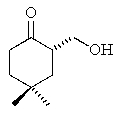
C)

D)
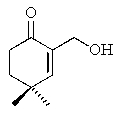
E)
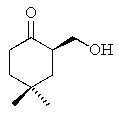

A)

B)

C)

D)

E)


3
What is the major product of the following reaction? 
A)

B)

C)

D)

E)


A)

B)

C)

D)

E)


4
What would be the major organic product of the following reaction? 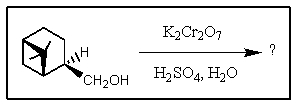
A)

B)

C)

D)

E)


A)

B)

C)

D)

E)


Unlock Deck
Unlock for access to all 39 flashcards in this deck.
Unlock Deck
k this deck
5
What is the major product of the following reaction? 
A)

B)

C)

D)

E) No reaction occurs.

A)

B)

C)

D)

E) No reaction occurs.

Unlock Deck
Unlock for access to all 39 flashcards in this deck.
Unlock Deck
k this deck
6
What would be the name of the following compound? 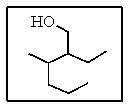
A) 3-hydroxymethyl-4-methylheptane
B) 2-sec-butyl-1-butanol
C) 2-ethyl-3-methyl-1-hexanol
D) 2-ethyl-3-propyl-1-butanol
E) 2-(sec-pentyl)-1-butanol

A) 3-hydroxymethyl-4-methylheptane
B) 2-sec-butyl-1-butanol
C) 2-ethyl-3-methyl-1-hexanol
D) 2-ethyl-3-propyl-1-butanol
E) 2-(sec-pentyl)-1-butanol

Unlock Deck
Unlock for access to all 39 flashcards in this deck.
Unlock Deck
k this deck
7
What is the major product of the following reaction? 
A)

B)

C)

D)

E) No net reaction occurs.

A)

B)

C)

D)

E) No net reaction occurs.

Unlock Deck
Unlock for access to all 39 flashcards in this deck.
Unlock Deck
k this deck
8
What is the major product of the following reaction? 
A)

B)

C)

D)

E)


A)

B)

C)

D)

E)


Unlock Deck
Unlock for access to all 39 flashcards in this deck.
Unlock Deck
k this deck
9
What is the major product of the following reaction? 
A)

B)

C)

D)

E) No net reaction occurs.

A)

B)

C)

D)

E) No net reaction occurs.

Unlock Deck
Unlock for access to all 39 flashcards in this deck.
Unlock Deck
k this deck
10
Grignard reagents are prepared in ether solvents because:
A) THF and diethyl ether will dissolve the Mg metal.
B) Ether solvents stabilize the Grignard reagent by coordination to the organomagnesium.
C) Ether solvents stabilize magnesium metal by forming a covalent bond.
D) Ethers have many acidic protons.
E) Ether solvents keep water away from the reaction.
A) THF and diethyl ether will dissolve the Mg metal.
B) Ether solvents stabilize the Grignard reagent by coordination to the organomagnesium.
C) Ether solvents stabilize magnesium metal by forming a covalent bond.
D) Ethers have many acidic protons.
E) Ether solvents keep water away from the reaction.

Unlock Deck
Unlock for access to all 39 flashcards in this deck.
Unlock Deck
k this deck
11
Which of the following would be the least miscible with (= least soluble in)water?
A)

B)

C)

D)

E) All have equal water solubility.
A)

B)

C)

D)

E) All have equal water solubility.

Unlock Deck
Unlock for access to all 39 flashcards in this deck.
Unlock Deck
k this deck
12
What would be the expected product(s)of the following reactions? 
A)

B)

C)

D)

E)
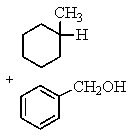

A)

B)

C)

D)

E)


Unlock Deck
Unlock for access to all 39 flashcards in this deck.
Unlock Deck
k this deck
13
Which statement about the preparation of Grignard reagents is not true? 
A) The reaction must be done in an ether solvent.
B) The reagent should be protected from air.
C) Methyl,primary,secondary,tertiary and aryl halides may be used.
D) Rearrangement may accompany Grignard formation.
E) The halogen may be chloride,bromide,or iodide.

A) The reaction must be done in an ether solvent.
B) The reagent should be protected from air.
C) Methyl,primary,secondary,tertiary and aryl halides may be used.
D) Rearrangement may accompany Grignard formation.
E) The halogen may be chloride,bromide,or iodide.

Unlock Deck
Unlock for access to all 39 flashcards in this deck.
Unlock Deck
k this deck
14
Predict the product of the following reaction: 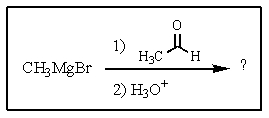
A)

B)

C)

D)

E)


A)

B)

C)

D)

E)


Unlock Deck
Unlock for access to all 39 flashcards in this deck.
Unlock Deck
k this deck
15
To which side,if any,would the following equilibrium lie? 
A) to the left
B) to the right
C) equally to the right and left
D) There is no way to tell.
E) This reaction cannot occur at all.

A) to the left
B) to the right
C) equally to the right and left
D) There is no way to tell.
E) This reaction cannot occur at all.

Unlock Deck
Unlock for access to all 39 flashcards in this deck.
Unlock Deck
k this deck
16
Which of the following five-carbon alcohols would you expect to be the most soluble in water?
A)

B)

C)

D)

E)

A)

B)

C)

D)

E)


Unlock Deck
Unlock for access to all 39 flashcards in this deck.
Unlock Deck
k this deck
17
What is the expected product of the following reaction? 
A)

B)

C)
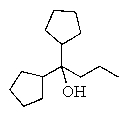
D)

E)


A)

B)

C)

D)

E)


Unlock Deck
Unlock for access to all 39 flashcards in this deck.
Unlock Deck
k this deck
18
Which of the following reactions would produce the alcohol shown? 
A)
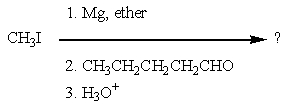
B)
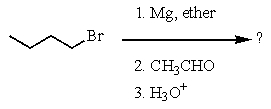
C)

D) All of these.
E) None of these.

A)

B)

C)

D) All of these.
E) None of these.

Unlock Deck
Unlock for access to all 39 flashcards in this deck.
Unlock Deck
k this deck
19
What reagent(s)would accomplish the following transformation? 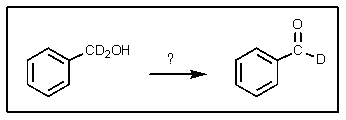
A) Pyridinium chlorochromate
B) LiAlD4 then H3O+
C) H2CrO4
D) Potassium dichromate
E) H2SO4

A) Pyridinium chlorochromate
B) LiAlD4 then H3O+
C) H2CrO4
D) Potassium dichromate
E) H2SO4

Unlock Deck
Unlock for access to all 39 flashcards in this deck.
Unlock Deck
k this deck
20
Which of the following reagents would accomplish the reaction shown? 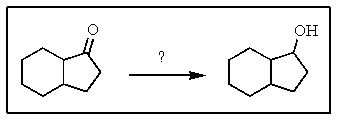
A) H2SO4,H2O
B) H2CrO4
C) O2 (slow)
D) HO-,H2O
E) None of the above.

A) H2SO4,H2O
B) H2CrO4
C) O2 (slow)
D) HO-,H2O
E) None of the above.

Unlock Deck
Unlock for access to all 39 flashcards in this deck.
Unlock Deck
k this deck
21
Choose the reagents to make the conversion from I to II. 
A) NaH
B) LiAlD4
C) NaBH4
D) H3O+
E) All of the above.

A) NaH
B) LiAlD4
C) NaBH4
D) H3O+
E) All of the above.

Unlock Deck
Unlock for access to all 39 flashcards in this deck.
Unlock Deck
k this deck
22
What would be the expected organic product of the following reaction? 
A)
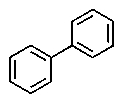
B)

C)

D)

E)
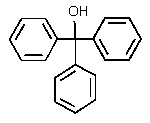

A)

B)

C)

D)

E)


Unlock Deck
Unlock for access to all 39 flashcards in this deck.
Unlock Deck
k this deck
23
For this series of alcohols,which one will have an equilibria that lies the furthest to the right in a basic solution? 
A) CH3OH
B) FCH2OH
C) ClCH2OH
D) BrCH2OH
E) All equilibria will be the same.

A) CH3OH
B) FCH2OH
C) ClCH2OH
D) BrCH2OH
E) All equilibria will be the same.

Unlock Deck
Unlock for access to all 39 flashcards in this deck.
Unlock Deck
k this deck
24
What is the product of the following reaction? 
A)

B)
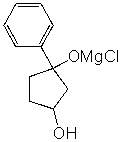
C)

D)

E) All of the above are the end products of this reaction.

A)

B)

C)

D)

E) All of the above are the end products of this reaction.

Unlock Deck
Unlock for access to all 39 flashcards in this deck.
Unlock Deck
k this deck
25
Which alcohol could be prepared by the greatest number of different combinations of Grignard reagents and carbonyl compounds (aldehydes,ketones,and/or esters)? (No multi-step reactions are intended here.)
A)

B)

C)

D)

E)

A)

B)

C)

D)

E)


Unlock Deck
Unlock for access to all 39 flashcards in this deck.
Unlock Deck
k this deck
26
Which of these reactions will give the product shown? 
A)

B)
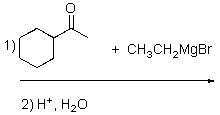
C)
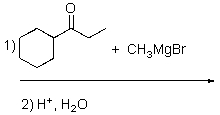
D) A and B are correct.
E) All of the above will give the product.

A)

B)

C)

D) A and B are correct.
E) All of the above will give the product.

Unlock Deck
Unlock for access to all 39 flashcards in this deck.
Unlock Deck
k this deck
27
Ingestion of which of the following toxic alcohols can cause blindness?
A) CH3OH
B) CH3CH2OH
C) (CH3)2CHOH
D) C6H5OH
E) HOCH2CH2OH
A) CH3OH
B) CH3CH2OH
C) (CH3)2CHOH
D) C6H5OH
E) HOCH2CH2OH

Unlock Deck
Unlock for access to all 39 flashcards in this deck.
Unlock Deck
k this deck
28
What would be the expected product for the following reaction? 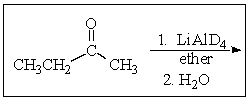
A)

B)

C)

D) CH3CH2CD2CH3
E)


A)

B)

C)

D) CH3CH2CD2CH3
E)


Unlock Deck
Unlock for access to all 39 flashcards in this deck.
Unlock Deck
k this deck
29
Rank the following alcohols in order of decreasing acidity in solution. 
A) 1 > 2 > 3 > 4
B) 2 > 1 > 3 > 4
C) 4 > 3 > 2 > 1
D) 4 > 3 > 1 > 2
E) 1 > 3 > 2 > 4

A) 1 > 2 > 3 > 4
B) 2 > 1 > 3 > 4
C) 4 > 3 > 2 > 1
D) 4 > 3 > 1 > 2
E) 1 > 3 > 2 > 4

Unlock Deck
Unlock for access to all 39 flashcards in this deck.
Unlock Deck
k this deck
30
Predict the major product of the following reaction: 
A)

B)

C)

D)

E) No reaction occurs.

A)

B)

C)

D)

E) No reaction occurs.

Unlock Deck
Unlock for access to all 39 flashcards in this deck.
Unlock Deck
k this deck
31
What would be the major organic product expected from the following reaction? 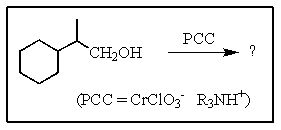
A)

B)

C)

D)

E)


A)

B)

C)

D)

E)


Unlock Deck
Unlock for access to all 39 flashcards in this deck.
Unlock Deck
k this deck
32
Which of the following reactions would produce the alcohol shown below? 
A)

B)

C)

D) All of the above.
E) Two of the above.

A)

B)

C)

D) All of the above.
E) Two of the above.

Unlock Deck
Unlock for access to all 39 flashcards in this deck.
Unlock Deck
k this deck
33
For the transformations below,what is the structure of the starting material? 
A)

B)

C)

D)

E)


A)

B)

C)

D)

E)


Unlock Deck
Unlock for access to all 39 flashcards in this deck.
Unlock Deck
k this deck
34
What is the major product of the following reaction? 
A)

B)

C)

D)

E)


A)

B)

C)

D)

E)


Unlock Deck
Unlock for access to all 39 flashcards in this deck.
Unlock Deck
k this deck
35
What is the product of the following reaction? 
A)

B)

C)

D)

E)


A)

B)

C)

D)

E)


Unlock Deck
Unlock for access to all 39 flashcards in this deck.
Unlock Deck
k this deck
36
Identify the reagent that you would use to go from PGE1 to PGE1 ? 
A) CrO3-2pyridine
B) NaH
C) NaBH4
D) H2O
E) H2SO4

A) CrO3-2pyridine
B) NaH
C) NaBH4
D) H2O
E) H2SO4

Unlock Deck
Unlock for access to all 39 flashcards in this deck.
Unlock Deck
k this deck
37
Which of these reagents will best accomplish the transformation below? 
A) NaOH,H2O
B)

C)
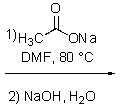
D)

E) None of the above.

A) NaOH,H2O
B)

C)

D)

E) None of the above.

Unlock Deck
Unlock for access to all 39 flashcards in this deck.
Unlock Deck
k this deck
38
What is the product of the following reaction? 
A)

B)

C)

D)

E) None of the above.

A)

B)

C)

D)

E) None of the above.

Unlock Deck
Unlock for access to all 39 flashcards in this deck.
Unlock Deck
k this deck
39
Rank the following organic compounds in order of increasing acidity. 
A) 1 < 4 < 3 < 2
B) 1 < 3 < 4 < 2
C) 2 < 1 < 3 < 4
D) 2 < 3 < 4 < 1
E) 1 < 4 < 2 < 3

A) 1 < 4 < 3 < 2
B) 1 < 3 < 4 < 2
C) 2 < 1 < 3 < 4
D) 2 < 3 < 4 < 1
E) 1 < 4 < 2 < 3

Unlock Deck
Unlock for access to all 39 flashcards in this deck.
Unlock Deck
k this deck



